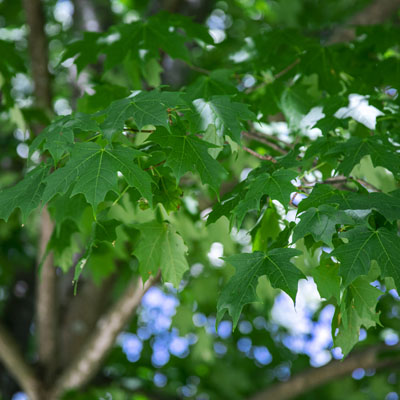Tree Catalog - Best Trees For Dayton, Ohio
Welcome to the Arbor Experts Tree Catalog, where you'll find photos and complete descriptions of the trees we most highly recommend for the Dayton, OH area. All of these trees will do well here and would be a beautiful addition to your yard.
Green Mountain Sugar Maple
Acer saccharum 'Green Mountain'





Sugar maples are found throughout Ohio, where their large leaves and spreading branches make excellent shade trees, their leaves provide vivid fall color, and their wood is prized for its tight grain and strength. ‘Green Mountain’ is a cultivar that’s been grown for almost 60 years, as it possesses some of the best qualities of the sugar maple, and is suited for Dayton’s climate zone 6A.
The ‘Green Mountain’ cultivar was selected for its attractive traits, including:
- Fast growth rate (2-3’ per year)
- Straight, central leader
- Good branching pattern
- Large, dark green leaves
- Orange/red fall color
- Pest and disease resistance
- Leaf scorch resistance
Tree Notes and Cautions
Among Green Mountain’s best characteristics are its large, pyramidal form and its dark green leaves. Its large size means that ‘Green Mountain’ is a good choice for large public spaces such as parks and campuses. Its spreading branches make pleasant shade in urban areas, but ‘Green Mountain’ does not tolerate narrow areas of compacted soil and winter road salt commonly found in these settings. Give the tree a planting area with a minimum width of six feet, to accommodate its root system, and keep road salt flushed from its soil.
During the rainy season, anthracnose can damage leaves. Its appearance can look similar to leaf scorch, but it is a fungus. Your tree can be sprayed with a fungicide in late winter or early spring when leaves are beginning to emerge. To ensure thorough coverage of the fungicide, spraying a large maple is best done with professional equipment. Other leaf diseases, such as canker or leaf spot, are usually not severe enough to require treatment. Clean up and discard any fallen, infected leaves, and make sure there is enough sunlight and wind reaching the interior of the tree crown.
‘Green Mountain’ sugar maple grows rapidly to 50-60’, and spreads to 30-50’, with a spreading, shallow root system. To avoid conflicts with landscape maintenance, do not plant this, or any maple, in a lawn. The tree’s canopy creates dense shade beneath it, which will inhibit turf growth and leave bare patches.
Irrigation for turf areas also encourages tree roots to grow right at the soil’s surface, threatening the maple’s already-shallow root system during excessive heat, drought, or when turf irrigation is stopped. Additionally, these surface tree roots can be easily damaged by mowers and edgers. A dressing of organic mulch is a better option beneath the tree, and mulch contributes to weed suppression and water conservation in the soil. As always, keep mulch away from direct contact with the tree’s trunk.
Growing Tips
Give your ‘Green Mountain’ Sugar Maple plenty of room for its large, mature crown and spreading branches. Its strong, balanced branching pattern makes ‘Green Mountain’ a low-maintenance cultivar, but eventually, its lower branches may need to be pruned up to maintain clearances for pedestrians and vehicles.
Maples can survive periods of drought, but your trees will look better and have greater resistance to pests and pathogens if their soil remains moist, especially during periods of high temperatures. Keep your soil from becoming compacted, ensure there is enough drainage to prevent standing water or saturated soils, and mulch within the tree’s dripline.
Some of the potential pathogens that can damage sugar maples, such as armillaria and verticillium wilt, are less likely to strike maples whose soil moisture levels and growing conditions are properly maintained.
Pests
Aphids are one of the few potential pests for ‘Green Mountain’ that can be controlled by spraying if beneficial insects do not control the aphid populations. Cottony scale insects may also be sprayed--with horticultural oil during dormancy.
NOTE: it is important to time any spraying carefully, as maples are sensitive to spraying and damage and die-back may occur if the tree’s sap has already begun to move after dormancy.
The other common pests that can affect ‘Green Mountain’, borers and mites, generally do not present serious problems and do not require spraying.
Any spraying you do needs to be timed to the life cycles of the intended insects, so be sure to check with your local experts before applying any oils or pesticides. Maintaining the populations of beneficial insects (which may be keeping insect pest populations down naturally) is of equal importance to your trees!
